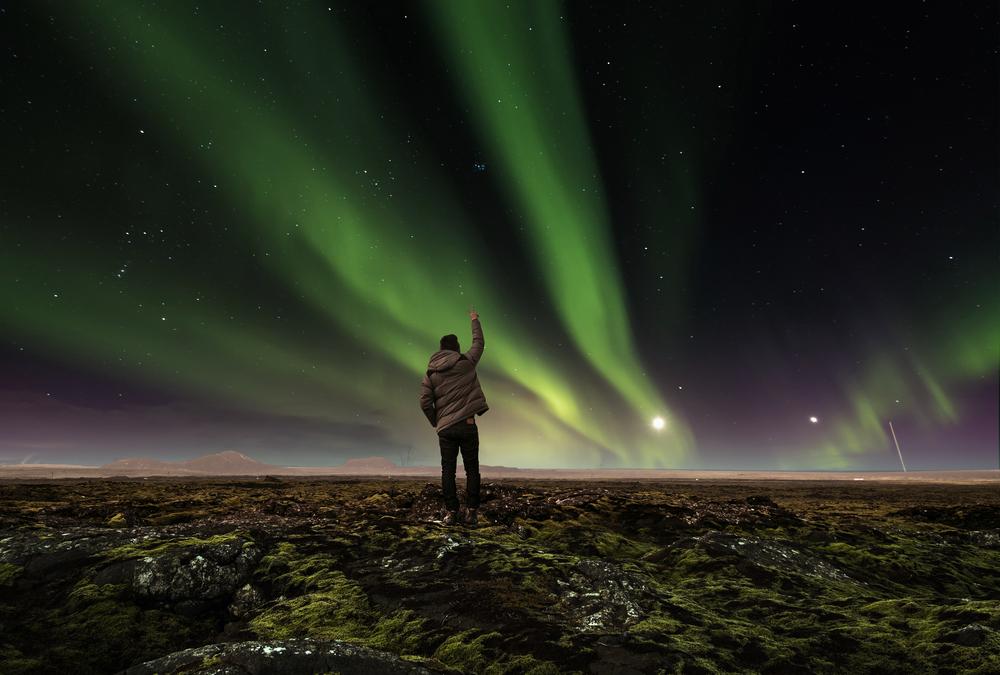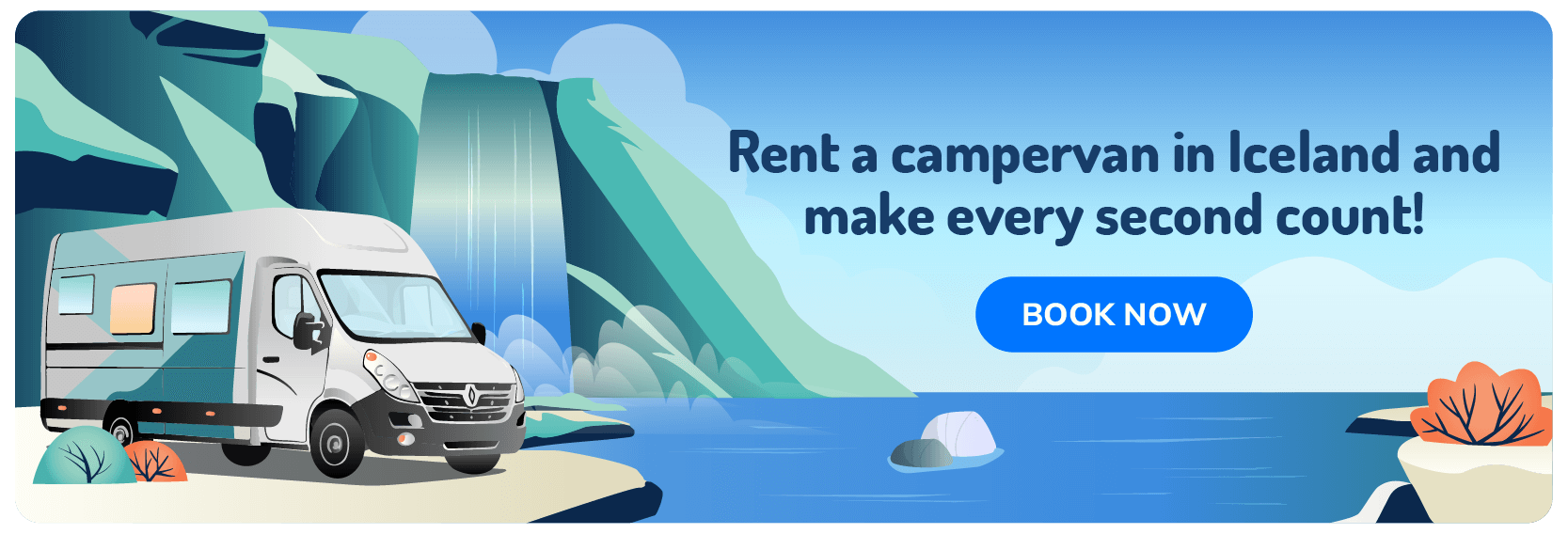Have you ever seen Earth interact with the cosmos? That is precisely what the Northern Lights are, and if you haven’t seen it yet, then coming to Iceland and witnessing this spectacle is exactly what you need.
So, when can you see the Northern Lights in Iceland? You will know the answer after reading through this article.
What Are the Northern Lights?
When looking up at the vivid dancing colors in the sky on a cold winter night, you must wonder how this is even possible. Many cultures have had different explanations for it: dead spirits, a bridge from the gods, quick foxes hitting mountains, etc.
The scientific explanation for the Northern Lights is much simpler than one might think. Thousands of kilometers away, the sun works hard to give us some well-needed light and energy. Sometimes, the sun sends out bursts of energy called solar flares that make it to us on Earth.
When these flares hit Earth, they immediately get reflected away from the planet by the magnetic field. This field keeps out all harmful radiation that would otherwise hit us and cause severe damage. Since the magnetic field “goes through” Earth at the poles, it has a different direction at those points. This allows a small portion of the energy from a solar flare to get trapped in the magnetic field, giving energy to some of the molecules in the atmosphere, which in turn sends light down to Earth.
That is what we see as the Northern Lights. This phenomenon is also why there is something called the Southern Lights, or Aurora Australis.

Where Can I See the Northern Lights in Iceland?
When you go hunting for the Northern Lights, or Aurora Borealis, in Iceland, you must be above the 60th° latitude. Luckily for you and everyone else hunting the Northern Lights in Iceland, the entire country is above that line. This means that you will be able to see it from places like the Blue Lagoon and even the most southern town of Vík!
However, you will have the best of luck if you stay away from all the city lights and focus your time on the countryside. The parts of the Icelandic Highlands that are open when you’re visiting will be great spots to head to. Just remember to be careful. Since the Northern Lights can only be seen in the dark, it means that you will likely be traveling at night, so you must ensure that you drive safely in Iceland when you’re out and about.

To get more detailed information on where to find the Northern Lights in Iceland, check the Aurora forecast on the Icelandic weather agency’s website. It shows where you will have the best chance of seeing the Northern Lights and at what time, and it has a forecast for several days. With that nifty tool in your hand, you can stay agile on your Northern Lights holiday in Iceland.

What Time of Day Can You See the Northern Lights?
As we mentioned earlier, the Northern lights in Iceland can only be seen in the dark, which implies that you might have to be out at night to catch them. For the most part, this is true, but there will be times of the year when you can see it in the nights and mornings.
Regardless of the time of year, the best time to view the Northern Lights is going to be the hours around midnight. This is important to know since some people might have trouble staying awake. Lucky for them, Icelanders are notorious for brewing strong coffee, so visiting the local coffee shop before you leave might be a saving grace.
The Northern Lights in Spring
Fall and spring in Iceland are the “down” seasons in Iceland for visitors. This means that you will be able to get travel and accommodation easily and affordably if you travel during these seasons. Unfortunately, you will struggle to see the Northern Lights for the most part, since the Iceland Northern Lights season is between September and April. If you come in early spring, you might have a fighting chance, but your odds won’t be great.

The Northern Lights in Summer
Ever heard of the Midnight Sun in Iceland? Well, that is an extraordinary thing to experience, but it also means that you will not be able to spot the Northern Lights this time of year. That means that the answer to the question “Can you see the Northern Lights in Iceland in May?” is going to be an unfortunate “no”.
Luckily, there are plenty of other things to do in summer in Iceland, so not seeing the Northern Lights won’t ruin the holiday.
The Northern Lights in Fall
The Iceland Northern Lights months are between April and September, so you will be able to see the lights from mid-fall. However, the later you come in the fall, the better your chances are. Still, your chances of seeing the Northern Lights in Iceland in September are still OK.
So, can you see the Northern Lights in Iceland in August? Unfortunately, your chances are incredibly slim. Miracles can happen, and you might get a cold and dark night without any clouds in the way, but for the most part, they are hard to see in fall in Iceland.
In general, the weather will be your worst enemy this time of year. The days are getting shorter, so you will have enough dark hours, but the clouds are notoriously relentless in the fall in Iceland. It’s the time of year when the weather goes from sunny and bright to rainy and windy.
The Northern Lights in Winter
If you want to catch the Northern Lights, winter in Iceland is the best season to aim for. This is the time of year when most of the country gets less than 4-5 hours of sunlight, meaning long nights, dark mornings, and dark afternoons.
If you go out in the countryside or simply stay away from the towns, you will also avoid all light pollution when trying to see the Northern Lights. There is even a place, Sandvik, that has a couple of days without any sunlight at all in the middle of winter. It’s an excellent place in Iceland to visit for a couple of days if you want a long and uninterrupted session with the Northern Lights.

How to Capture the Northern Lights
If you have ever seen a beautiful moon you wanted to catch in a photo, you know the pain of snapping a picture just to have it come out like the first pancake of a Saturday morning batch. There are a few tips and tricks for getting a good photo of the Northern Lights.
- Quality gear is key. Most mobile phone cameras are not up for the task, so make sure you have a good camera or a phone with a high-quality camera.
- A well-balanced ISO and aperture will make all the difference for the best details. If you don’t get these settings right, the photos will appear grainy.
- To get the right amount of light in the picture, a long shutter speed is a must. You won’t be able to catch any lights if the shutter speed is too short.
- Get a stand with a camera holder. We all have great faith in our ability to hold things steady, but even the slightest tremble will show in the image.
Where to Stay to See the Northern Lights
Getting a proper look at the Iceland skies at night is incredibly important on the hunt for the perfect Northern Lights. Below are some accommodation options and how to utilize them for the best results.
Hotels
A hotel is great if you want to stay in Reykjavik or any larger town. For Northern Lights hunting, it’s not so great. The city lights tend to drown out the Northern Lights, so you must drive out of the city or get on a Northern Lights tour to have a fighting chance.
Farm Stays
This is the in-between (and not in a Stranger Things kind of way) for those who don’t want to have a camping adventure but also don’t want to sit in a hotel room. Booking a farm stay will get you far enough away from any light pollution and allow you to see the Northern Lights, whilst also being able to enjoy a little luxury. Some farm stays will also get you up close with some of our farm animals.
Camping
We are the biggest fans of camping. If you want to get close to nature and experience Iceland as it should be, getting in a motorhome and chasing the Northern Lights is your best option. Camping is the most affordable accommodation option, and you won’t be close to any city lights.
Pick the Right Time to See the Northern Lights in Iceland
Knowing the answer to the question “When are the Northern Lights in Iceland?” is 80% of the success. Now you know that you’ll need to stick to the winter season to get the best possible chance of seeing the Northern Lights, it’s time to book that flight, rent a motorhome in Iceland and hit the road to find the Northern Lights!


